
Extravehicular activity (EVA) is any activity done by an astronaut in outer space outside a spacecraft. In the absence of a breathable Earthlike atmosphere, the astronaut is completely reliant on a space suit for environmental support. EVA includes spacewalks and lunar or planetary surface exploration. In a stand-up EVA (SEVA), an astronaut stands through an open hatch but does not fully leave the spacecraft. EVAs have been conducted by the Soviet Union/Russia, the United States, Canada, the European Space Agency and China.

A space suit is an environmental suit used for protection from the harsh environment of outer space, mainly from its vacuum as a highly specialized pressure suit, but also its temperature extremes, as well as radiation and micrometeoroids. Basic space suits are worn as a safety precaution inside spacecrafts in case of loss of cabin pressure. For extravehicular activity (EVA) more complex space suits are worn, featuring a portable life support system.
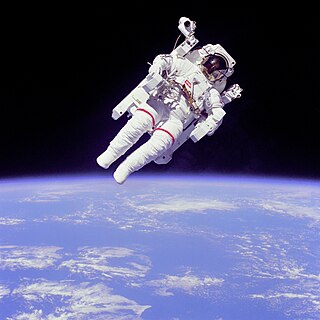
The Manned Maneuvering Unit (MMU) is an astronaut propulsion unit that was used by NASA on three Space Shuttle missions in 1984. The MMU allowed the astronauts to perform untethered extravehicular spacewalks at a distance from the shuttle. The MMU was used in practice to retrieve a pair of faulty communications satellites, Westar VI and Palapa B2. Following the third mission the unit was retired from use. A smaller successor, the Simplified Aid For EVA Rescue (SAFER), was first flown in 1994, and is intended for emergency use only.

STS-41-B was NASA's tenth Space Shuttle mission and the fourth flight of the Space ShuttleChallenger. It launched on February 3, 1984 and landed on February 11, 1984, after deploying two communications satellites. It was also notable for including the first untethered spacewalk.
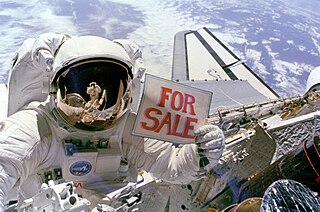
STS-51-A was the 14th flight of NASA's Space Shuttle program, and the second flight of Space Shuttle Discovery. The mission launched from Kennedy Space Center on November 8, 1984, and landed just under eight days later on November 16, 1984.

Bruce McCandless II was an American Navy officer and aviator, electrical engineer, and NASA astronaut. In 1984, during the first of his two Space Shuttle missions, he completed the first untethered spacewalk by using the Manned Maneuvering Unit.

STS-57 was a NASA Space Shuttle-Spacehab mission of Space ShuttleEndeavour that launched June 21, 1993, from Kennedy Space Center, Florida.

STS-61 was NASA's first Hubble Space Telescope servicing mission, and the fifth flight of the Space Shuttle Endeavour. The mission launched on December 2, 1993, from Kennedy Space Center (KSC) in Florida. The mission restored the spaceborne observatory's vision with the installation of a new main camera and a corrective optics package (COSTAR). This correction occurred more than three and a half years after the Hubble was launched aboard STS-31 in April 1990. The flight also brought instrument upgrades and new solar arrays to the telescope. With its very heavy workload, the STS-61 mission was one of the most complex in the Shuttle's history.

STS-64 was a Space Shuttle Discovery mission that was set to perform multiple experiment packages. It was Discovery's 19th flight. STS-64 was launched from Kennedy Space Center, Florida, on 9 September 1994, and landed back on 20 September 1994 at Edwards Air Force Base.
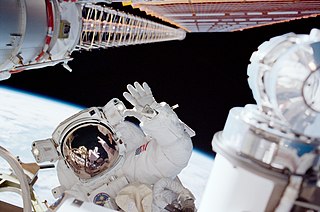
STS-97 was a Space Shuttle mission to the International Space Station (ISS) flown by Space Shuttle Endeavour. The crew installed the first set of solar arrays to the ISS, prepared a docking port for arrival of the Destiny Laboratory Module, and delivered supplies for the station's crew. It was the last human spaceflight of the 20th century.

Jeffrey Alan Hoffman is an American former NASA astronaut and currently a professor of aeronautics and astronautics at MIT.

Peter Jeffrey Kelsay Wisoff is an American physicist and former NASA astronaut. Wisoff qualified as mission specialist and flew in four Space Shuttle missions, with his first launch in 1993 and his last in 2000.

The Extravehicular Mobility Unit (EMU) is an independent anthropomorphic spacesuit that provides environmental protection, mobility, life support, and communications for astronauts performing extravehicular activity (EVA) in Earth orbit. Introduced in 1981, it is a two-piece semi-rigid suit, and is currently one of two types of EVA spacesuits used by crew members on the International Space Station (ISS), the other being the Russian Orlan space suit. It was used by NASA's Space Shuttle astronauts prior to the end of the Shuttle program in 2011.

The Quest Joint Airlock is the primary airlock for the International Space Station. Quest was designed to host spacewalks with both Extravehicular Mobility Unit (EMU) spacesuits and Orlan space suits. The airlock was launched on STS-104 on July 14, 2001.

William Frederick Fisher is an American physician and a former NASA astronaut. Fisher went into space in 1985 on board the Space Shuttle. He retired from NASA in 1992 and returned to the full-time practice of medicine. His time at NASA coincided with that of his former wife and fellow astronaut Anna Lee Fisher. He is also the great grandson of Pony Express rider William Frederick Fisher

STS-116 was a Space Shuttle mission to the International Space Station (ISS) flown by Space Shuttle Discovery. Discovery lifted off on December 9, 2006 for her 33rd flight at 20:47:35 EST. A previous launch attempt on December 7 had been canceled due to cloud cover. It was the first night launch of a Space Shuttle since STS-113 in November 2002.
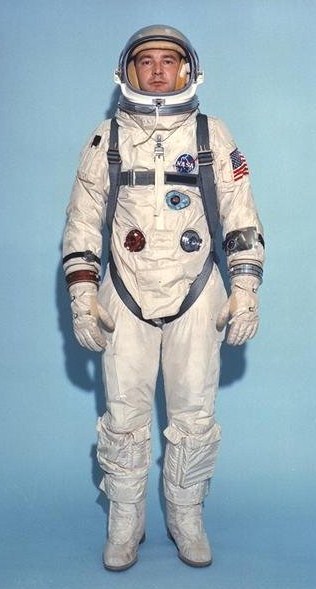
The Gemini spacesuit is a spacesuit worn by American astronauts for launch, in-flight activities and landing. It was designed by NASA based on the X-15 high-altitude pressure suit. All Gemini spacesuits were developed and manufactured by the David Clark Company in Worcester, Massachusetts.
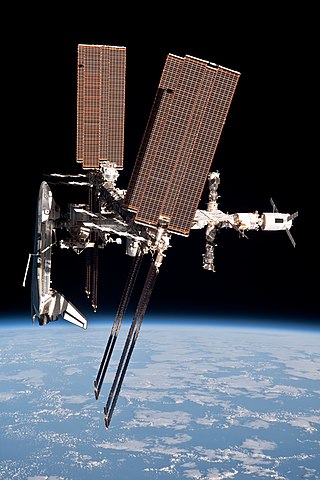
STS-134 was the penultimate mission of NASA's Space Shuttle program and the 25th and last spaceflight of Space ShuttleEndeavour. This flight delivered the Alpha Magnetic Spectrometer and an ExPRESS Logistics Carrier to the International Space Station. Mark Kelly served as the mission commander. STS-134 was expected to be the final Space Shuttle mission if STS-135 did not receive funding from Congress. However, in February 2011, NASA stated that STS-135 would fly "regardless" of the funding situation. STS-135, flown by Atlantis, took advantage of the processing for STS-335, the Launch on Need mission that would have been necessary if the STS-134 crew became stranded in orbit.

An astronaut propulsion unit is used to move an astronaut relative to the spaceship during a spacewalk. The first astronaut propulsion unit was the Hand-Held Maneuvering Unit (HHMU) used on Gemini 4.

Charles Edward "Ed" Whitsett Jr. (1936-1993) was a USAF officer and NASA engineer specializing in solutions for effective human movement in zero gravity. The pinnacle of his work was the astronaut maneuvering unit (MMU) which enabled satellite rescue and repair. For this capability, Whitsett along with NASA, Martin Marietta, Bruce McCandless, and Walter W. Bollendonk received the 1984 Robert J. Collier Trophy for "the greatest achievement in aeronautics or astronautics in America."



















